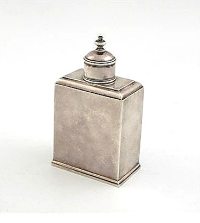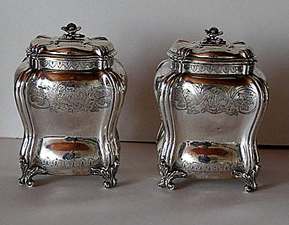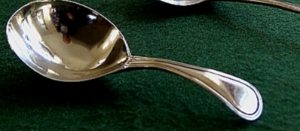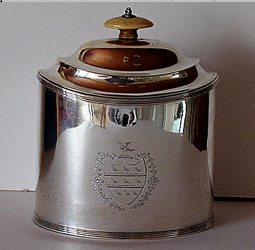(click on photos to enlarge image)
THE EARLY HISTORY OF THE ENGLISH TEA CADDY
Although it is believed that Thomas Garway (or Garraway)
first served tea in his coffee house in London in about 1658 it
did not become widely accepted until after the 'Restoration'
when it was popularised by Catherine of Braganza, who brought
the tea drinking habit with her from the continent.
Tea drinking in the 17th century appears to have continued in
Coffee Houses and, although something is known about these
coffee houses and who frequented them, very little is known
about how it was served or how it was kept in the commercial
quantities necessary for trade. The first intimation we have of
tea drinking as a social habit carried on in the home is at the
end of the 17th century and at this juncture some container for
keeping tea in the home would have become necessary although, to
the best of this author’s understanding, there are no 17th
century tea caddies known.
The name is taken from the Malay word ‘kati’ which was a
specific unit of weight used for measuring tea but not related
in any way to the amount an English caddy would hold. The
earliest tea caddy known to this author was made by Thomas Ash
and is dated 1708 but it was not until the reign of George I (1714 - 1727)
that silversmiths began making these containers in sufficient
quantity that examples can readily be found today.
These early tea caddies were of fairly simple
construction and design, taking a bottle-like form
with straight sides, shoulders and a narrow neck
with a pull off cap.
Apart from engraved armorials these caddies usually
have no decoration except, sometimes, for the finial
surmounting the cap.
It has been ascertained from pictorial
representations of early 18th century tea drinking
that this cap was used to dispense the tea into the
pot.
|
 |
| |
George I tea caddy by John Chartier London c
1720-23 (see Note) - Picture by kind permission
of Woolley & Wallis, Auctioneers of Salisbury -
|
Tea was a very expensive commodity in the 18th century and
was heavily taxed. By the middle of the century the tax imposed
on tea was 119% and it became necessary to devise a method of
preventing theft. Lockable wooden boxes, some quite ornately
decorated, were produced in which a pair of caddies could be
kept securely. These boxes were in use by the reign of Geo II as
can be seen from the following: "Advice To The Waiting Maid" in
the publication Directions to Servants by Jonathan Swift and
published in 1745. He makes the observation; "the Invention of
small Chests and Trunks, with Lock and Key, wherein they keep
the Tea and Sugar, without which it is impossible for the
Waiting maid to live......".
It should be noted that some experts make the claim that the
central compartment or container in these boxes was for blending
the teas. However, although there is evidence that Thomas
Twining, one of the earliest purveyors of loose tea, was
blending tea as early as the reign of George I, there is no
evidence that it was blended at the table and the above extract
from Swift's "Directions to Servants" shows quite clearly that
the third container was for sugar.
Caddies were being made in pairs because by the end of the 17th
century not only Hyson (green) tea was being imported from China
but also Bohey (black) tea and it was considered desirable to
have both on offer at the tea table. Sometimes caddies were
engraved with the letter 'H' on one and the letter 'B' on the
other so that the same sort of tea was always kept in the same
caddy.
 |
The design of these mid 18th century tea caddies
was beginning to follow contemporary fashion so that
the bombé shape is common, and some are ornately
decorated in the rococo style while others, as in
the case of those illustrated here, relied on
engraving for their decoration.
By this date the narrow neck has been replaced by a
hinged or lift off lid so that some way of
transferring the tea from the caddy to the pot was
necessary. Teaspoons had been introduced by the end
of the 17th century and it must be assumed that
these were used as 'caddy spoons' since the spoon
specially designed for this purpose was not made
until the seventeen seventies.
|
Pair of tea caddies by John Kincard London 1756
|
|
Some of the boxes made to contain a pair of
caddies were, as can be seen in the above quotation
from Jonathan Swift, also provided with a glass bowl
in which sugar, which was also an expensive
commodity, was kept and occasionally a set of three
matching silver containers can be found showing that
sugar was considered an essential part of the tea
drinking ceremony by this date. Although these
wooden boxes continued to be made well into the 19th
century and beyond, by the end of the 18th century
silver caddies were produced to stand on their own
and these were equipped with their own locks.
|

|
| |
Caddy Spoon by Peter & Ann Bateman London 1795
(the date of this spoon differs from that of its
caddy - see below - because it was probably assayed
on 28th May 1796, the last marking day of 1795,
whereas the caddy was assayed the following day,
29th May, the first marking day of 1796)
|
These caddies are usually decorated in the
fashion of the time with quite ornate brightcut
engraving although some, like the one illustrated
here, are quite plain. As these caddies have locks,
lift off lids are less common at this date and
hinged lids with quite large finials are usual.
By the time these caddies were being produced the
caddy spoon had been invented and these were often
made en suite with the caddy. They can be quite
pretty and are collected in their own right.
|
 |
| |
Tea Caddy by Peter & Ann Bateman
London 1796 (note the keyhole)
|

|
During the 19th century silver tea caddies fell
out of vogue and the wooden boxes were produced with
zinc lined compartments in which the tea could be
stored. Silver tea caddies were mostly, therefore,
an 18th century phenomenon but are an interesting
part of English tea drinking history.
(left) 19th century tea caddy showing the
central compartment for sugar. The right hand tea
compartment is shown with its decorative lid in
place whilst the left hand compartment is shown with
its inner preserving lid in place. This secondary
lid is close fitting and rested on the tea to keep
the air out thus keeping it dry.
|
David McKinley
- 2010 -
David McKinley devotes much of his time to researching
the history of silversmithing in England with particular
reference to hallmarking at the London office. He writes
for both The Silver Spoon Club of Great Britain and The
Silver Society.
|
|
 ASSOCIATION OF SMALL COLLECTORS OF ANTIQUE SILVER
ASSOCIATION OF SMALL COLLECTORS OF ANTIQUE SILVER ASSOCIATION OF SMALL COLLECTORS OF ANTIQUE SILVER
ASSOCIATION OF SMALL COLLECTORS OF ANTIQUE SILVER